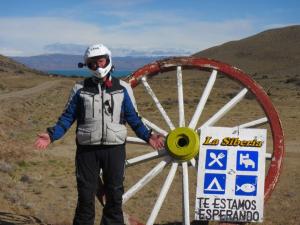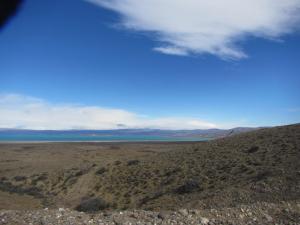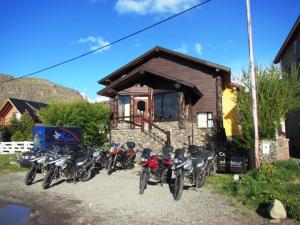Date: 11/17/2014 Monday
Starting Location: Estancia La Angostura, Patagonia Argentina
Ending Location: El Chalten, Argentina
Mileage Today: 172 Miles
Mileage Total: 1197.8 miles
Leaving Estancia La Angostura
We left the Estancia at exactly 8:00 AM. The breakfast was great. We had farm-fresh eggs, fresh squeezed Orange Juice, breads, a very nice Jam, and some form of Granola. To be honest, when you travel like this you tend to eat just about anything, and not sweat the details. But, in this case, the folks at this farm did a really great job to get us off on the right foot.
I was able to capture video of our departure from the Estancia. The “driveway” was about 4 miles long, which then takes you to an intersection with the RN 29. RN 29 is one of those highways that is really a dirt road, with a highway number. It does not rally resemble a highway in any other way.
The Gravel, the wind
Leaving the Estancia we had about 3 miles of gravel road to get to the gravel road. At the gravel road we took a left, and headed towards the gravel road, which in this part of the world, is Ruta 40, or RN 40, or Route Nacional 40. In any case, it is the major N/S highway, and it’s mostly gravel. Go figure.
There are four things that can make gravel roads even harder to ride than normal. These 4 things are 1) Rain 2) Snow 3) Darkness and 4) Wind. In our case, it was good old number 4 that bit us. When I say bit us, I mean that as we were riding along on RN 40, seemingly minding our own business, the wind would rise up, like a demon from beneath the Earth, and it would attack with a swift hand and an evil heart. This wind was mean, and we had apparently angered it.
After a series of consults on the matter, it seems that the wind was not angry at all. It just has a bad attitude, and it’s always like that. Just like trying to deal with someone who has a perpetually uneven temperament, sometimes you have to just accept them, and move on. And so with the winds of Patagonia, that’s what I attempted to do. But, I fear that we’ve not heard the last of our ill-tempered friend from below (or is it above?).
In the tour brochure, they spoke about some of the roads being at a difficulty level of 4 out of 5. We were told that today is one of the roads that is at difficulty level 4.
After the initial 3 miles, we had about 120 km of gravel road, which lead us directly to some beautiful newly tarred roads. But, this was not to last. Within a few miles, we were back on gravel, and between this point, and the end of the road for the day, we had about another 30 km of gravel roads to deal with.
I would like to say that eventually you get used to the gravel, and to some extent this is true, but mostly you get better at dealing with gravel, and you get much better at reading the line in the road.
Choosing the right line is critical, and reading the road to find the right line is a very important skill to develop.
The 120 Km of gravel was broken up into segments which were about 30 Km each. Breaking up the ride like this allowed us to regroup every 30 minutes or so, and to also relax a bit between each segment. I had the GPS, and so I had the additional benefit of knowing in advance when the next photo op, gas stop, or lunch break would be.
Insert videos of the gravel
Guanacos – More of same…
Prior to my departure for Patagonia a little over a week ago, I had been telling all of you (that would listen) that I was hoping to come around a corner, and to come face to face with a llama. Well, as it turns out, there are no wild Llamas in Argentina, but as I’ve noted several times, there are wild Guanacos. Think of a Guanaco as an Argentinian Llama, and you’ll get the picture.
So, anyway, I was riding this morning, rounded a urn, and low and behold, on the side of the road were a number of Guanocs.
Insert the video of the Guanacos
Siberia – What the he%$?
 At the 60 Km point, we stopped to regroup, and we knew that we were at the right place because in this part of the world, there are not too many reference points, but this was one that we were told about in advance. So, we stopped to regroup and for pictures.
At the 60 Km point, we stopped to regroup, and we knew that we were at the right place because in this part of the world, there are not too many reference points, but this was one that we were told about in advance. So, we stopped to regroup and for pictures.
This sign is at the entrance to an Estancia, which I can only assume is called Siberia. I tried to take some pictures of the Estancia itself, but it was probably about a mile or more from the road, and the camera just couldn’t get enough detail to produce a nice shot. So, after a few minutes of waiting for the others, and a few photos, we moved on.
Big, Bold, Blue lakes
 At about the 70 Km point in the 120 miles of gravel, we came over a rise and came upon a pretty majestic bit of scenery. The lakes below are all fed from the glaciers, and they are an amazing shade of blue.
At about the 70 Km point in the 120 miles of gravel, we came over a rise and came upon a pretty majestic bit of scenery. The lakes below are all fed from the glaciers, and they are an amazing shade of blue.
The lake is in the distance, and difficult to see in this form, but simply click on the picture itself and see the picture full-size. At this point, we’re approaching the town of Tres Lagos, and for you gringos out there, the name means 3 lakes, so I’m sure that this is one of many lakes, but for now, we’ll all imagine that there are only 3 of them.
The Glaciares National Park
About 6 miles before you arrive at El Chalten, you come to the entrance to the Glacier National Park. We had hoped to get a picture that shows Mt. Fitzroy in the background, but just as we arrived at the monument, it started to rain. So, our 6 mile journey into El Chalten was in the rain, and wind of Patagonia. Once again, this is what we bought and paid for. There should not be any surprises on my face, or the faces of my fellow travelers.
INSERT PICTURES OF PARK MONUMENT
El Chalten
 El Chalten is a little town, created in 1985 to secure the disputed border with Chile, and as a result of Argentina wanting more of the tourist trade. The town is located at the base of Mt. Fitzroy, within Glacier National Park, Patagonia, Argentina.. The mountain is quite striking, when you’re able to see it, but as I’ve been told, the clouds, fog, and rain often conspire to keep ol’ Fitz hidden from sight. Our plan is to hike up Mt. Fitz Roy tomorrow (Tuesday).
El Chalten is a little town, created in 1985 to secure the disputed border with Chile, and as a result of Argentina wanting more of the tourist trade. The town is located at the base of Mt. Fitzroy, within Glacier National Park, Patagonia, Argentina.. The mountain is quite striking, when you’re able to see it, but as I’ve been told, the clouds, fog, and rain often conspire to keep ol’ Fitz hidden from sight. Our plan is to hike up Mt. Fitz Roy tomorrow (Tuesday).
The Internet & cell phone capabilities in this little town range from spotty to downright horrible. So, the amount of work and patience required to create this post is quite high, and as you know, I’m not long on patience, so if it was not for the beauty of this place, this would have been a much tougher day.
Dinner & The cost of things…
It’s easy to find yourself in a restaurant in Patagonia where you don’t know what choices you have for dinner, and even with the help of your fellow traveler, you do your best to choose something that you might enjoy. The problem is that even when the Argentinians give you an English language description, it does not mean that you’ll get what you want.
Last night, for example… I thought that it might be nice to have a piece of lamb, grilled, and served with a Malbec reduction sauce. I realize that this sounds a bit optimistic on my part, but that’s what it said on the menu.
As it turns out, I got almost exactly what I wanted, but the meat did not taste like lamb, and it certainly tasted more like beef. Since I had no idea how to convey my doubts about the origin of the species of the meat, I figured I would just leave it alone, and enjoy the Bamb. The good news is that the whole meal was quite good, but not inexpensive. The course of Bamb, smashed carrots and some kind of potato item was about $20 USD or so.
I split a $18 USD bottle of Malbec with Stan, and it proved to be quite good. To date, since arriving in Argentina, this is the most expensive bottle of wine we’ve had. Other bottles of Malbec have cost us between $4.50 and $10 USD.
The sunset at El Chalten
Don’t know, didn’t see it. Sorry, maybe tomorrow…
He pushes his motorcycle across Patagonia.
Gravel moves out of his way purely out of respect.
He IS the most interesting man in the world.
Stay thirsty, my friend.
Well now, I nearly split a gut when I read this.
Thanks Sis
Is your Spanish getting better?
Si,
My Spanish is getting a little bit better, and I’m now able to ask for my room key, beers, ham and cheese sandwiches, coffee, and a few other staples, but I’m far from conversational at this point.
I wish that I had spent more time learning the language before the trip. This, is my only regret.